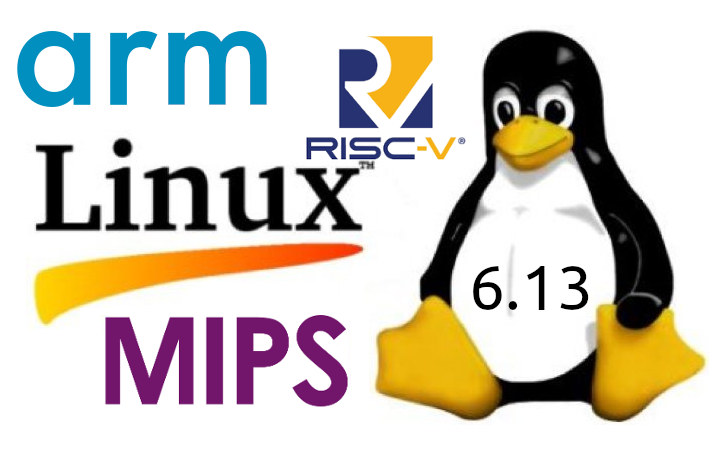We’ve already covered Raspberry Pi HAT+ boards with multiple M.2 sockets with various keyings including the Geekworm X1004 HAT+, Pineboards HatDrive! AI, and HatDrive! Dual with two sockets, and the Geekworm X1011 with four M.2 Key-M sockets. So when I saw Seeed Studio introduced a dual M.2 HAT+ board I initially thought it was uninteresting being a very similar board. However, all aforementioned PCIe to M.2 HAT+ boards are based on either the ASMedia ASM1182e or ASM1184e PCIe Gen2 x1 packet switches with 5GT/s shared bandwidth, and Seeed Studio’s PCIe3.0 to Dual M.2 HAT+ for Raspberry Pi 5 features instead an ASMedia ASM2806 PCIe 3.0 switch supporting up to 8GT/s shared bandwidth through the Raspberry Pi 5’s PCIe Gen3 x1 interface. Seeed Studio PCIe 3.0 to Dual M.2 HAT+ key features and specifications: Supported SBC – Raspberry Pi 5 and potentially other SBCs with a PCIe FFC connector like the […]
Linux 6.13 Release – Main changes, Arm, RISC-V, and MIPS architectures
Linus Torvalds has just announced the release of Linux 6.13 on the Linux Kernel Mailing List: So nothing horrible or unexpected happened last week, so I’ve tagged and pushed out the final 6.13 release. It’s mostly some final driver fixes (gpu and networking dominating – normal), with some doc updates too. And various little stuff all over. The shortlog is appended for people who want to see the details (and, as always, it’s just the shortlog for the last week, the full 6.13 log is obviously much too big). With this, the merge window for 6.14 will obviously open tomorrow. I already have two dozen pull requests pending – thank you, you know who you are. Linus Release about two months ago, Linux 6.12 – the new LTS version – brought us real-time “PREEMPT_RT” support that had always required out-of-tree patchsets until now, the completion of the EEVDF (Earliest Eligible […]
NextPCB offers free PCBA prototypes for RP2350/RP2040 designs, RP2040 MCU as low as 30 cents (Sponsored)
NextPCB Accelerator is an initiative from the PCB and PCBA manufacturer to empower innovators and creators to bring their ideas to life, and the ongoing campaign features the Raspberry Pi RP2350 and RP2040 microcontrollers. Specifically, NextPCB offers two free PCBA prototypes for any original design based on either the RP2350 Cortex-M33/RISC-V microcontroller or RP2040 Arm Cortex-M0+ MCU from Raspberry Pi. The company also offers subsidized bulk pricing for the Raspberry Pi RP2040 for any company or maker mass-producing their design with NextPCB. Besides PCB manufacturing, NextPCB will offer professional assembly of the RP2040 or RP2350 chips using their precision pick-and-place machines, advanced automated inspection equipment, and carefully controlled manufacturing practices. NextPCB’s IC programming and firmware burning services will free up time for customers, and functional testing services will make sure all prototypes are tested for functionality before leaving the production line. The conditions of the offer are pretty straightforward. NextPCB […]
BANDIT PC32 standalone ColorForth keyboard computer is powered by the Raspberry Pi RP2350 microcontroller
BANDIT PC32 is a Raspberry Pi RP2350-powered keyboard computer that runs a graphically-oriented version of the ColorForth programming environment. The BANDIT PC32 is primarily aimed at on-the-go use for programming video games. The custom, 32-key split keyboard takes up most of the build, with a 3.2-inch 320 x 240 capacitive display in the center. It also features an HDMI port for connecting a larger external display. The 48-pin GPIO is divided into two female headers and can be used to interface with other devices directly. This is the second version of the Bandit standalone computer, building on an early prototype based on the RP2040 microcontroller. We have seen several interesting RP2350-based products like the Inky Frame 7.3”, 4D Systems display modules, and Jumperless V5 programmable breadboard. However, this is the first RP2350 standalone computer we have come across. It shares some similarities with the ESP32 Rainbow. BANDIT PC32 ColorForth specifications: […]
Open hardware RP2350B boards offer up to 16MB flash, 8MB PSRAM, microSD card slot, 48x GPIOs
Olimex has recently released the PICO2-XL and PICO2-XXL open-source hardware RP2350B development boards with up to 16MB flash, 8MB PSRAM, 48 GPIOs, a microSD card slot, and more. The main difference between the two boards is that the PICO2-XL includes 2MB of external QSPI Flash and a compact flat-bottom design, making it ideal for simpler, space-constrained projects. In contrast, the PICO2-XXL offers 16MB of QSPI Flash, 8MB of PSRAM, and a microSD card slot for expanded storage and performance, catering to more demanding applications like IoT and edge computing. Olimex PICO2-XL and PICO2-XXL specifications SoC – Raspberry Pi RP2350B MCU CPU Dual-core Arm Cortex-M33 @150MHz with Arm Trustzone Dual-core 32-bit Hazard3 RISC-V @ 150MHz Up to two cores can be used at the same time Memory – 520KB SRAM 8kB OTP storage Security – Secure boot Package – QFN-80; 10×10 mm Memory – 8MB PSRAM (PICO2-XXL only) Storage PICO2-XL – […]
ESP32-based Waveshare DDSM Driver HAT (B) for Raspberry Pi supports DDSM400 hub motors
Waveshare has recently launched DDSM Driver HAT (B), a compact Raspberry Pi DDSM (Direct Drive Servo Motor) motor driver designed specifically to drive the DDSM400 hub motors. This board is built around an ESP32 MCU and supports wired (USB and UART) and wireless (2.4GHz WiFi) communication. Additionally, the board features a physical toggle switch, which lets it choose between the ESP32 control or USB control modes. On ESP32 control mode you can control the device through a built-in web application. In the USB control mode, the motor driver can be controlled via USB from a host computer sending JSON commands. An XT60 connector is used to power the board, and programming is done through a USB-C port that connects to the ESP32. The board is suitable for robotics projects, especially for mobile robots in 6×6 or 4×4 configurations. Waveshare DDSM Driver HAT (B) specifications: Wireless MCU – Espressif Systems ESP32-WROOM-32E ESP32 […]
Ditronix’s IPEM PiHat turns your Raspberry Pi into a mains power energy monitor (Crowdfunding)
The IPEM PiHat is a HAT (Hardware Attached on Top) board for the Raspberry Pi that turns the single-board computer into a mains power energy monitor with four CT clamps. It provides an accurate way to track energy usage in home, office, and solar energy systems and is compatible with single-phase, two-phase, and three-phase electrical systems. The Raspberry Pi-based power energy monitor uses CT (current transformer) cable clamps to sample and measure data which can be used to report and analyze electric energy usage. This data can be used to save and divert energy to reduce costs and inefficiencies. The system is easy to set up and does not require a professional electrician. It uses a CT current clamp clipped over the building’s main power cables and connected to the local mains circuit for voltage and frequency measurement. The add-on board comes in two variants: IPEM PiHat and IPEM PiHat […]
OpenFlexture Microscope is an open-source, 3D-printed microscope based on Raspberry Pi 4 SBC and Camera Module v2
The OpenFlexture Microscope is a DIY, open-source, 3D-printed microscope built around the Raspberry Pi 4, a Raspberry Pi Camera Module v2, and a choice of optics or various qualities up to lab-grade optics. It can be motorized using low-cost geared stepper motors and can achieve a resolution of up to around 100 nanometers I found out about the OpenFlexture Microscope in one of the sessions at the upcoming FOSDEM 2025 event whose description partially reads: The OpenFlexure Microscope is an open-source laboratory-grade digital robotic microscope. As a robotic microscope, it is able to automatically scan microscope slides creating, enormous multi-gigapixel digital representations of samples. The microscope is already undergoing evaluation for malaria and cancer diagnosis in Tanzania, Rwanda, and the Philippines. As an open project, our key goal is to support local manufacturing of microscopes in low-resource settings. [..] high-quality consistent documentation has enabled thousands of microscopes to be built […]










